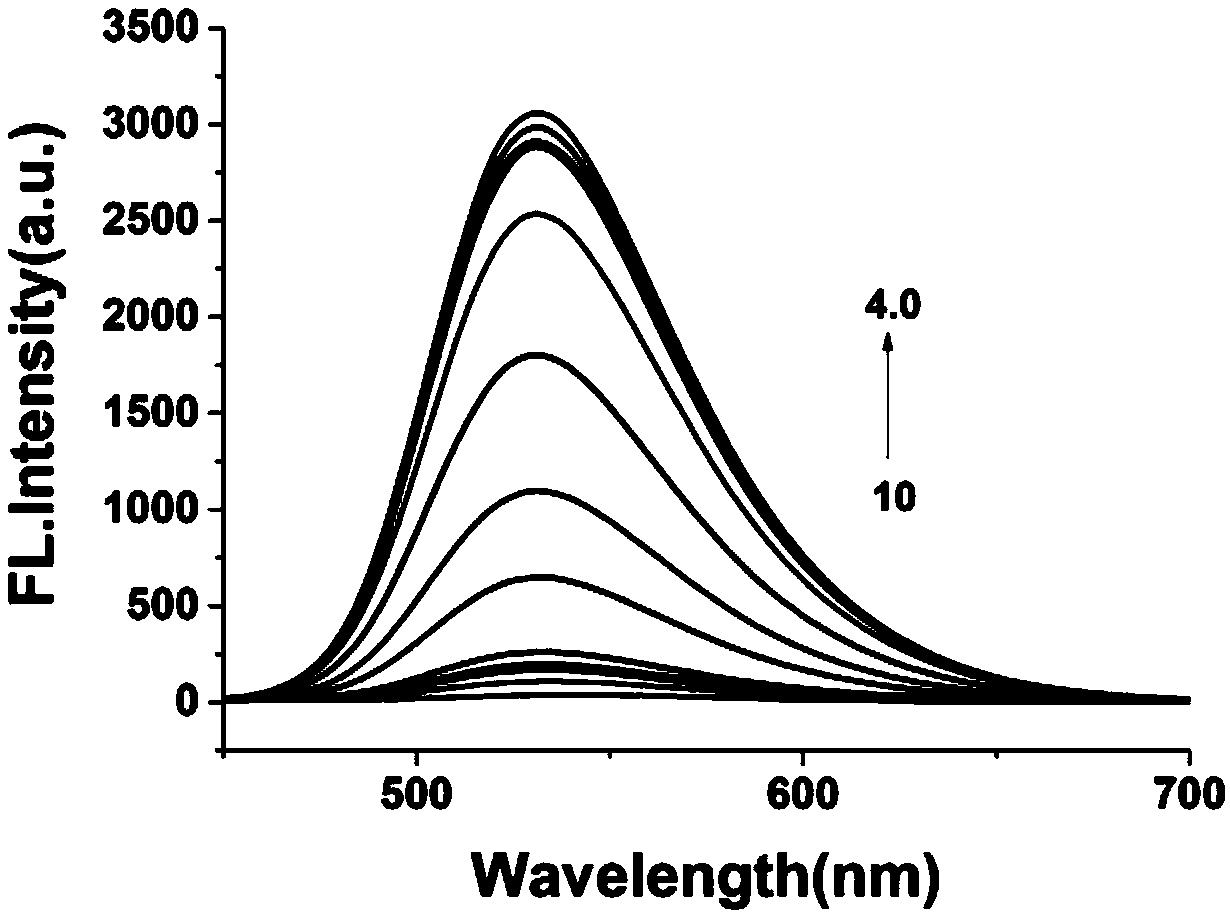Two-photon fluorescent probe for detecting pH in endoplasmic reticulum of cell
A technology of fluorescent probes and endoplasmic reticulum, applied in the direction of fluorescence/phosphorescence, luminescent materials, measuring devices, etc., can solve the problems of high cost, cumbersome synthesis steps, few fluorescent probes for positioning endoplasmic reticulum, etc., and achieve high specificity , raw materials are cheap and easy to obtain, and the effect of good fluorescence emission spectral characteristics
- Summary
- Abstract
- Description
- Claims
- Application Information
AI Technical Summary
Problems solved by technology
Method used
Image
Examples
Embodiment 1
[0038] Example 1 Synthesis of Fluorescent Probes
[0039] (1) Dissolve 4-bromo-1,8-naphthalic anhydride (1 mmol) in 25 mL ethanol and heat under reflux until completely dissolved, then dissolve BOC-ethylenediamine (1 mmol) in 2 mL ethanol and add dropwise into the reaction liquid, continue to reflux and stir for 4 hours, suction filter to obtain a white solid, and perform column chromatography with ethyl acetate:petroleum ether=3:1 (v / v) as the eluent to obtain compound 1;
[0040] (2) All of the above compound 1 was dissolved in 20 mL of dichloromethane, 2.5 mL of trifluoroacetic acid was added dropwise, and stirred at room temperature for 3 hours. After spin-drying, column chromatography was performed with methanol:dichloromethane=15:1 (v / v) as the eluent to obtain compound 2;
[0041] (3) Dissolve compound 2 (0.5 mmol) in 15 mL of dichloromethane, add p-toluenesulfonyl chloride (0.5 mmol) in dichloromethane dropwise to the above solution under ice-salt bath (-5°C) , stirr...
Embodiment 2
[0044] Example 2 Responses of fluorescent probes to different pH environments
[0045] The probe obtained in Example 1 was dissolved in ethanol, and then diluted with water to form a 10 μM probe buffer solution (containing 10% ethanol). Take 13 parts of the above-mentioned probe solution, add the same volume of pH buffer solution respectively, so that the pH is 4.0, 4.5, 5.0, 5.5, 6.0, 6.5, 7.0, 7.5, 8.0, 8.5, 9.0, 9.5, 10.0. Then perform a fluorescence scan (λ Ex =400 nm); calculate the relative fluorescence intensity in each system. The response of the probe to different pH as figure 2 Shown: Its maximum fluorescence intensity peak is 531nm. The corresponding light intensity at 531 nm (I 531nm ) as the ordinate and pH as the abscissa, we get image 3 , we know that I 531nm There is a linear correlation between the fluorescence intensity and pH, and the fluorescence intensity decreases with the increase of pH.
Embodiment 3
[0046] Example 3 Selectivity of Fluorescent Probes
[0047] The probe obtained in Example 1 was dissolved in ethanol, and then diluted with water to form a 10 μM probe buffer solution (containing 10% ethanol). Take 15 parts of the above-mentioned probe solution 5 mL, add them separately, then add water or different interfering substances PBS buffer to the system in turn, and then perform fluorescence scanning (λ Ex = 400 nm); calculate the relative fluorescence intensity in each system; take the corresponding light intensity at 531nm (I 531nm ) is the ordinate, and the histogram of the response of the probe to different substances is obtained, such as Figure 4 Shown: Among them, 1: water; 2: Na + (5mM); 3: K + (5mM); 4: Ca 2+ (500μM); 5: Mg 2+ (500μM); 6: Al 3+ (200μM); 7: Cu 2+ (200μM); 8: Fe 3+ (200μM); 9: Zn 2+ (500μM); 10: GSH(5mM); 11: Cys(5mM); 12:HCys(5mM); 13: H 2 o 2 (5mM); 14: NaClO (200μM); 15: pH 4.0. according to Figure 4 It can be seen that the re...
PUM
 Login to View More
Login to View More Abstract
Description
Claims
Application Information
 Login to View More
Login to View More - R&D
- Intellectual Property
- Life Sciences
- Materials
- Tech Scout
- Unparalleled Data Quality
- Higher Quality Content
- 60% Fewer Hallucinations
Browse by: Latest US Patents, China's latest patents, Technical Efficacy Thesaurus, Application Domain, Technology Topic, Popular Technical Reports.
© 2025 PatSnap. All rights reserved.Legal|Privacy policy|Modern Slavery Act Transparency Statement|Sitemap|About US| Contact US: help@patsnap.com



